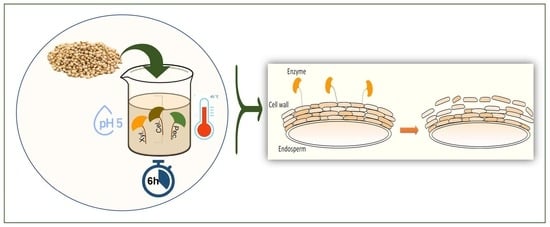Formulation of a Synergistic Enzyme Cocktail for Controlled Degradation of Sorghum Grain Pericarp
Abstract
1. Introduction
2. Materials and Methods
2.1. Raw Material and Chemicals
2.2. Sample Preparation and Enzyme Treatment
2.3. Experimental Mixture Design
2.4. Biochemical Analyses
2.4.1. Proximate and Mineral Composition
2.4.2. Total Soluble Solids
2.4.3. Reducing Sugars
2.4.4. Glucose
2.4.5. Xylose
2.4.6. Galacturonic Acid
2.4.7. Total Condensed Tannins
2.4.8. Total Phytate
2.5. Statistical Analyses and Optimisation
2.6. Time Course of Enzymatic Hydrolysis
2.7. Characterisation Techniques
2.7.1. Scanning Electron Microscopy
2.7.2. X-ray Diffraction (XRD) Pattern
3. Results and Discussion
3.1. Proximate and Mineral Composition
3.2. Biochemical Analysis of Pericarp Extract
3.2.1. Total Soluble Solids (TSS)
3.2.2. Reducing Sugars (RS)
3.2.3. Glucose
3.2.4. Xylose
3.2.5. Galacturonic Acid (GalA)
3.2.6. Anti-Nutrients
3.3. Optimal Enzyme Mixture Composition
3.4. Time Course Release of Pericarp Constituents
3.5. Morphological Characteristics
3.6. X-ray Diffraction Analysis
4. Conclusions
Author Contributions
Funding
Institutional Review Board Statement
Informed Consent Statement
Data Availability Statement
Acknowledgments
Conflicts of Interest
Appendix A
| Runs | Cocktail Combinations with Overall Enzyme Concentration = 50 mg/100 g dm | Enzyme Activities (U/mL) | ||
|---|---|---|---|---|
| Xylanase | Cellulase | Pectinase | ||
| 1 | 0:0:50P | 0 | 0 | 1.8 |
| 2 | 0:25C:25P | 0 | 1.125 | 0.9 |
| 3 | 0:50C:0 | 0 | 2.25 | 0 |
| 4 | 8.33X:8.33C:33.33P | 0.094 | 0.375 | 1.2 |
| 5 | 8.33X:33.33C:8.33P | 0.094 | 1.5 | 0.3 |
| 6 | 16.67X:16.67C:16.67P | 0.188 | 0.75 | 1.2 |
| 7 | 25X:0:25P | 0.281 | 0 | 0.9 |
| 8 | 25X:25C:0 | 0.281 | 1.125 | 0 |
| 9 | 33.33X:8.33C:8.33P | 0.375 | 0.375 | 0.3 |
| 10 | 50X:0:0 | 0.562 | 0 | 0 |
Appendix B
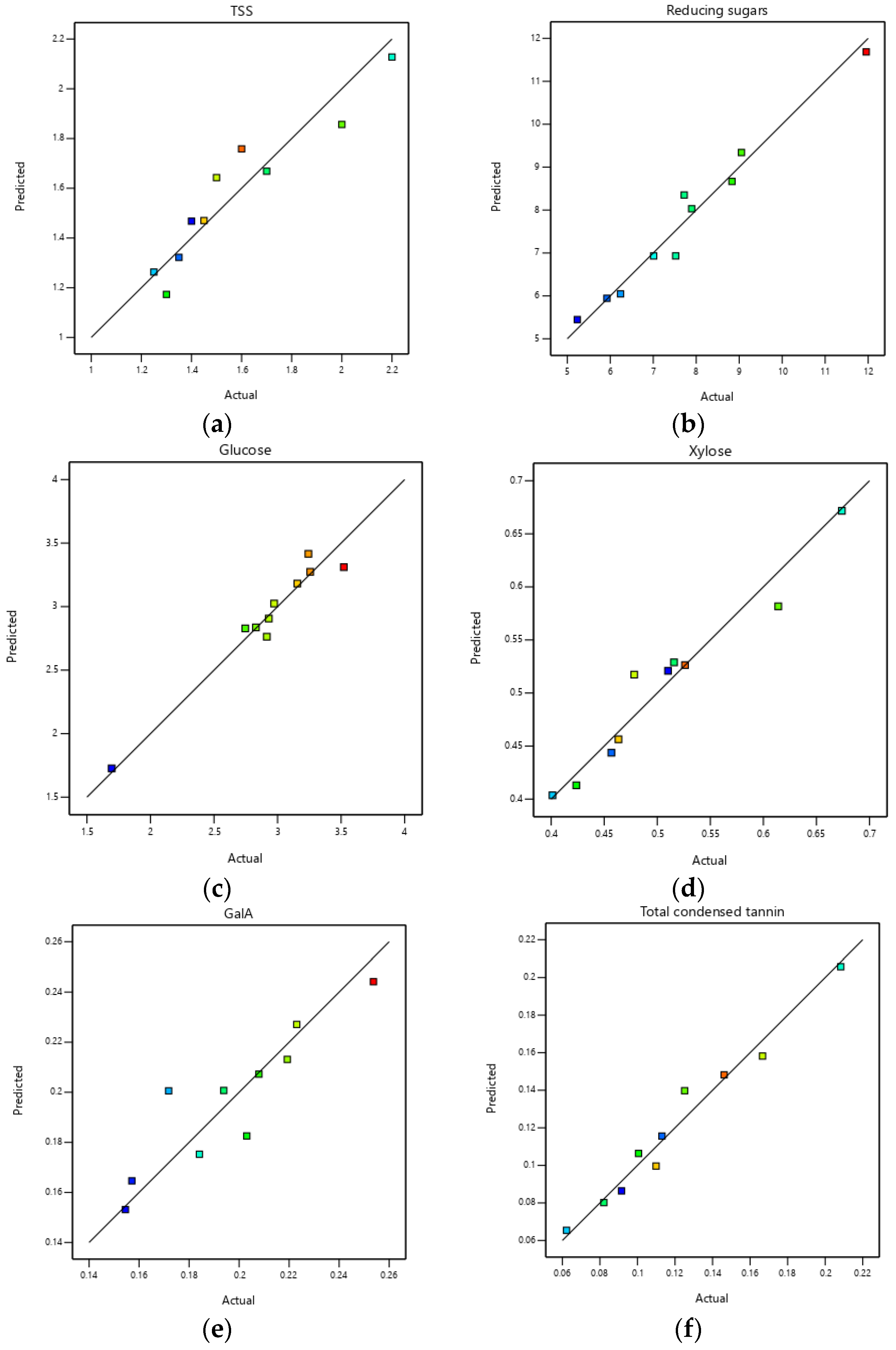

References
- de Oliveira, K.G.; Queiroz, V.A.V.; Carlos, L.d.A.; Cardoso, L.d.M.; Pinheiro-Sant’Ana, H.M.; Anunciação, P.C.; de Menezes, C.B.; da Silva, E.C.; Barros, F. Effect of the Storage Time and Temperature on Phenolic Compounds of Sorghum Grain and Flour. Food Chem. 2017, 216, 390–398. [Google Scholar] [CrossRef]
- FAO. Food and Agriculture Organization of the United Nation. Available online: https://www.fao.org/faostat/en/#data/QCL (accessed on 25 November 2021).
- Wu, G.; Johnson, S.K.; Bornman, J.F.; Bennett, S.J.; Singh, V.; Simic, A.; Fang, Z. Effects of Genotype and Growth Temperature on the Contents of Tannin, Phytate and in Vitro Iron Availability of Sorghum Grains. PLoS ONE 2016, 11, e0148712. [Google Scholar] [CrossRef] [PubMed]
- Xiong, Y.; Zhang, P.; Warner, R.D.; Fang, Z. Sorghum Grain: From Genotype, Nutrition, and Phenolic Profile to Its Health Benefits and Food Applications. Compr. Rev. Food Sci. Food Saf. 2019, 18, 2025–2046. [Google Scholar] [CrossRef] [PubMed]
- Sruthi, N.U.; Rao, P.S. Effect of Processing on Storage Stability of Millet Flour: A Review. Trends Food Sci. Technol. 2021, 112, 58–74. [Google Scholar] [CrossRef]
- Queiroz, V.A.V.; da Silva Aguiar, A.; de Menezes, C.B.; de Carvalho, C.W.P.; Paiva, C.L.; Fonseca, P.C.; da Conceição, R.R.P. A Low Calorie and Nutritive Sorghum Powdered Drink Mix: Influence of Tannin on the Sensorial and Functional Properties. J. Cereal Sci. 2018, 79, 43–49. [Google Scholar] [CrossRef]
- Awika, J.M. Sorghum: Its Unique Nutritional and Health-Promoting Attributes. In Gluten-Free Ancient Grains: Cereals, Pseudocereals, and Legumes: Sustainable, Nutritious, and Health-Promoting Foods for the 21st Century; Elsevier: Amsterdam, The Netherlands, 2017; pp. 21–54. ISBN 9780081008911. [Google Scholar]
- Wu, G.; Bornman, J.F.; Bennett, S.J.; Clarke, M.W.; Fang, Z.; Johnson, S.K. Individual Polyphenolic Profiles and Antioxidant Activity in Sorghum Grains Are Influenced by Very Low and High Solar UV Radiation and Genotype. J. Cereal Sci. 2017, 77, 17–23. [Google Scholar] [CrossRef]
- Usman, M.A.; Bolade, M.K.; James, S. Functional Properties of Weaning Food Blends from Selected Sorghum (Sorghum Bicolor (L.) Moench) Varieties and Soybean (Glycine Max). Afr. J. Food Sci. 2016, 10, 112–121. [Google Scholar]
- Aruna, C.; Suguna, M.; Visarada, K.B.R.S.; Deepika, C.; Ratnavathi, C.V.; Tonapi, V.A. Identification of Sorghum Genotypes Suitable for Specific End Uses: Semolina Recovery and Popping. J. Cereal Sci. 2020, 93, 102955. [Google Scholar] [CrossRef]
- Goodall, M.A.; Campanella, O.H.; Ejeta, G.; Hamaker, B.R. Grain of High Digestible, High Lysine (HDHL) Sorghum Contains Kafirins Which Enhance the Protein Network of Composite Dough and Bread. J. Cereal Sci. 2012, 56, 352–357. [Google Scholar] [CrossRef]
- Johnson, S.K.; Kaur, G.; Luitel, S.; Hoang, L.A.P.; Bhattarai, R.R. Replacement of Buckwheat by Black Sorghum Flour on Soba-Type Noodles. Int. J. Food Sci. Technol. 2021, 56, 5861–5870. [Google Scholar] [CrossRef]
- Liu, L.; Herald, T.J.; Wang, D.; Wilson, J.D.; Bean, S.R.; Aramouni, F.M. Characterization of Sorghum Grain and Evaluation of Sorghum Flour in a Chinese Egg Noodle System. J. Cereal Sci. 2012, 55, 31–36. [Google Scholar] [CrossRef]
- Khoddami, A.; Messina, V.; Vadabalija Venkata, K.; Farahnaky, A.; Blanchard, C.L.; Roberts, T.H. Sorghum in Foods: Functionality and Potential in Innovative Products. Crit. Rev. Food Sci. Nutr. 2021, 1–17. [Google Scholar] [CrossRef] [PubMed]
- Mkandawire, N.L.; Weier, S.A.; Weller, C.L.; Jackson, D.S.; Rose, D.J. Composition, in Vitro Digestibility, and Sensory Evaluation of Extruded Whole Grain Sorghum Breakfast Cereals. Food Sci. Technol. 2015, 62, 662–667. [Google Scholar] [CrossRef]
- Sruthi, N.U.; Rao, P.S.; Rao, B.D. Decortication Induced Changes in the Physico-Chemical, Anti-Nutrient, and Functional Properties of Sorghum. J. Food Compos. Anal. 2021, 102, 104031. [Google Scholar] [CrossRef]
- Zhao, Y.; Ambrose, R.P.K. Structural Characteristics of Sorghum Kernel: Effects of Temperature. Int. J. Food Prop. 2017, 20, 2630–2638. [Google Scholar] [CrossRef]
- Rytioja, J.; Hildén, K.; Yuzon, J.; Hatakka, A.; de Vries, R.P.; Mäkelä, M.R. Plant-Polysaccharide-Degrading Enzymes from Basidiomycetes. Microbiol. Mol. Biol. Rev. 2014, 78, 614–649. [Google Scholar] [CrossRef]
- Singh, A.; Karmakar, S.; Jacob, B.S.; Bhattacharya, P.; Kumar, S.P.J.; Banerjee, R. Enzymatic Polishing of Cereal Grains for Improved Nutrient Retainment. J. Food Sci. Technol. 2015, 52, 3147–3157. [Google Scholar] [CrossRef]
- Das, M.; Gupta, S.; Kapoor, V.; Banerjee, R.; Bal, S. Enzymatic Polishing of Rice–A New Processing Technology. Food Sci. Technol. 2008, 41, 2079–2084. [Google Scholar] [CrossRef]
- Haros, M.; Rosell, C.M.; Benedito, C. Improvement of Flour Quality through Carbohydrases Treatment during Wheat Tempering. J. Agric. Food Chem. 2002, 50, 4126–4130. [Google Scholar] [CrossRef]
- Sangani, V.P.; Patel, N.C.; Bhatt, V.M.; Davara, P.R.; Antala, D.K. Optimization of Enzymatic Hydrolysis of Pigeon Pea for Cooking Quality of Dhal. Int. J. Agric. Biol. Eng. 2014, 7, 123–132. [Google Scholar] [CrossRef]
- Johnston, D.B.; Singh, V. Enzymatic Milling of Corn: Optimization of Soaking, Grinding, and Enzyme Incubation Steps. Cereal Chem. 2004, 81, 626–632. [Google Scholar] [CrossRef]
- Thite, V.S.; Nerurkar, A.S. Xylanases of Bacillus Spp. Isolated from Ruminant Dung as Potential Accessory Enzymes for Agro-Waste Saccharification. Lett. Appl. Microbiol. 2015, 60, 456–466. [Google Scholar] [CrossRef] [PubMed]
- AOAC. Official Methods of Analysis of the Association of Official Analytical Chemists; Association of Official Analytical Chemists: Hoboken, NJ, USA, 1991; Volume 242. [Google Scholar]
- Singh, A.; Sharma, S.; Singh, B. Effect of Germination Time and Temperature on the Functionality and Protein Solubility of Sorghum Flour. J. Cereal Sci. 2017, 76, 131–139. [Google Scholar] [CrossRef]
- Kapoor, K.; Tyagi, A.K.; Diwan, R.K. Effect of Gamma Irradiation on Recovery of Total Reducing Sugars from Delignified Sugarcane Bagasse. Radiat. Phys. Chem. 2020, 170, 108643. [Google Scholar] [CrossRef]
- Sarkar, N.; Aikat, K. Kinetic Study of Acid Hydrolysis of Rice Straw. ISRN Biotechnol. 2013, 2013, 170615. [Google Scholar] [CrossRef]
- Yang, J.S.; Mu, T.H.; Ma, M.M. Extraction, Structure, and Emulsifying Properties of Pectin from Potato Pulp. Food Chem. 2018, 244, 197–205. [Google Scholar] [CrossRef] [PubMed]
- Kumar, A.; Srinivasa Rao, P. Optimization of Pulsed-Mode Ultrasound Assisted Extraction of Bioactive Compounds from Pomegranate Peel Using Response Surface Methodology. J. Food Meas. Charact. 2020, 14, 3493–3507. [Google Scholar] [CrossRef]
- Buddrick, O.; Jones, O.A.H.; Cornell, H.J.; Small, D.M. The Influence of Fermentation Processes and Cereal Grains in Wholegrain Bread on Reducing Phytate Content. J. Cereal Sci. 2014, 59, 3–8. [Google Scholar] [CrossRef]
- Loubes, M.A.; Flores, S.K.; Tolaba, M.P. Effect of Formulation on Rice Noodle Quality: Selection of Functional Ingredients and Optimization by Mixture Design. Food Sci. Technol. 2016, 69, 280–286. [Google Scholar] [CrossRef]
- Myers, R.H.; Montgomery, D.C.; Anderson-Cook, C.M. Response Surface Methodology: Process and Product Optimization Using Designed Experiments; John Wiley and Sons: Hoboken, NJ, USA, 2016; ISBN 1118916034. [Google Scholar]
- Stefoska-Needham, A.; Beck, E.J.; Johnson, S.K.; Tapsell, L.C. Sorghum: An Underutilized Cereal Whole Grain with the Potential to Assist in the Prevention of Chronic Disease. Food Rev. Int. 2015, 31, 401–437. [Google Scholar] [CrossRef]
- Hama, F.; Icard-Vernière, C.; Guyot, J.P.; Picq, C.; Diawara, B.; Mouquet-Rivier, C. Changes in Micro- and Macronutrient Composition of Pearl Millet and White Sorghum during in Field versus Laboratory Decortication. J. Cereal Sci. 2011, 54, 425–433. [Google Scholar] [CrossRef]
- Wu, G.; Ashton, J.; Simic, A.; Fang, Z.; Johnson, S.K. Mineral Availability Is Modified by Tannin and Phytate Content in Sorghum Flaked Breakfast Cereals. Food Res. Int. 2018, 103, 509–514. [Google Scholar] [CrossRef] [PubMed]
- Galán, M.G.; Llopart, E.E.; Drago, S.R. Losses of Nutrients and Anti-Nutrients in Red and White Sorghum Cultivars after Decorticating in Optimised Conditions. Int. J. Food Sci. Nutr. 2018, 69, 283–290. [Google Scholar] [CrossRef] [PubMed]
- Serna-Saldivar, S.O.; Espinosa-Ramírez, J. Grain Structure and Grain Chemical Composition. In Sorghum and Millets; Elsevier: Amsterdam, The Netherlands, 2019; pp. 85–129. [Google Scholar]
- Fan, Y.; Cai, Y.; Li, X.; Jiao, L.; Xia, J.; Deng, X. Effects of the Cellulose, Xylan and Lignin Constituents on Biomass Pyrolysis Characteristics and Bio-Oil Composition Using the Simplex Lattice Mixture Design Method. Energy Convers. Manag. 2017, 138, 106–118. [Google Scholar] [CrossRef]
- Favarato, L.F.; de Souza, J.L.; Galvão, J.C.C.; de Souza, C.M.; de Souza Balbino, J.M.; Guarçoni, R.C. Qualitative Attributes and Postharvest Conservation of Green Ears of Maize Grown on Different Cover Crops in Organic No-till System. Rev. Ceres 2016, 63, 532–537. [Google Scholar] [CrossRef]
- Miafo, A.P.T.; Koubala, B.B.; Kansci, G.; Muralikrishna, G. Free Sugars and Non-Starch Polysaccharides–Phenolic Acid Complexes from Bran, Spent Grain and Sorghum Seeds. J. Cereal Sci. 2019, 87, 124–131. [Google Scholar] [CrossRef]
- Hu, J.; Arantes, V.; Saddler, J.N. The Enhancement of Enzymatic Hydrolysis of Lignocellulosic Substrates by the Addition of Accessory Enzymes Such as Xylanase: Is It an Additive or Synergistic Effect? Biotechnol. Biofuels 2011, 4, 36. [Google Scholar] [CrossRef]
- Qiu, S.; Yadav, M.P.; Yin, L. Characterization and Functionalities Study of Hemicellulose and Cellulose Components Isolated from Sorghum Bran, Bagasse and Biomass. Food Chem. 2017, 230, 225–233. [Google Scholar] [CrossRef]
- Lin, Z.X.; Zhang, H.M.; Ji, X.J.; Chen, J.W.; Huang, H. Hydrolytic Enzyme of Cellulose for Complex Formulation Applied Research. Appl. Biochem. Biotechnol. 2011, 164, 23–33. [Google Scholar] [CrossRef]
- Dutta, N.; Mukhopadhyay, A.; Dasgupta, A.K.; Chakrabarti, K. Improved Production of Reducing Sugars from Rice Husk and Rice Straw Using Bacterial Cellulase and Xylanase Activated with Hydroxyapatite Nanoparticles. Bioresour. Technol. 2014, 153, 269–277. [Google Scholar] [CrossRef]
- Singh, S.; Rajulapati, V.; Jamaldheen, S.B.; Moholkar, V.S.; Goyal, A. Statistically Designed Cellulase Mixture for Saccharification of Pretreated Sorghum Durra Stalk. Ind. Crops Prod. 2020, 154, 112678. [Google Scholar] [CrossRef]
- Pinheiro, V.E.; Horváth, I.S.; Lundin, M.; Polizeli, M. de L.T. de M. Screening and Cocktail Optimization Using Experimental Mixture Design: Enzymatic Saccharification as a Biological Pretreatment Strategy. Biofuels Bioprod. Biorefin. 2021, 15, 1447–1460. [Google Scholar] [CrossRef]
- Yu, P.; McKinnon, J.J.; Maenz, D.D.; Olkowski, A.A.; Racz, V.J.; Christensen, D.A. Enzymic Release of Reducing Sugars from Oat Hulls by Cellulase, as Influenced by Aspergillus Ferulic Acid Esterase and Trichoderma Xylanase. J. Agric. Food Chem. 2003, 51, 218–223. [Google Scholar] [CrossRef]
- Tabka, M.G.; Herpoël-Gimbert, I.; Monod, F.; Asther, M.; Sigoillot, J.C. Enzymatic Saccharification of Wheat Straw for Bioethanol Production by a Combined Cellulase Xylanase and Feruloyl Esterase Treatment. Enzym. Microb. Technol. 2006, 39, 897–902. [Google Scholar] [CrossRef]
- Stoklosa, R.J.; Latona, R.J.; Bonnaillie, L.M.; Yadav, M.P. Evaluation of Arabinoxylan Isolated from Sorghum Bran, Biomass, and Bagasse for Film Formation. Carbohydr. Polym. 2019, 213, 382–392. [Google Scholar] [CrossRef]
- Shehzadi, A.; Raza, A.; Haider, Q.; Adnan, M.; Ali, S.R.; Ijaz, A. Xylanase; Production to Characterization and Substrate Interactions. Int. J. Appl. Biol. Forensics 2017, 1, 110–118. [Google Scholar]
- Yan, J.; Zhang, B.; Wu, F.; Yan, W.; Lv, P.; Yadav, M.; Jia, X.; Yin, L. Diverse Mechanical Properties and Microstructures of Sorghum Bran Arabinoxylans/Soy Protein Isolate Mixed Gels by Duo-Induction of Peroxidase and Calcium Ions. Food Hydrocoll. 2020, 107, 105946. [Google Scholar] [CrossRef]
- Singh, A.; Sharma, V.; Banerjee, R.; Sharma, S.; Kuila, A. Perspectives of Cell-Wall Degrading Enzymes in Cereal Polishing. Food Biosci. 2016, 15, 81–86. [Google Scholar] [CrossRef]
- Keyata, E.O.; Tola, Y.B.; Bultosa, G.; Forsido, S.F. Premilling Treatments Effects on Nutritional Composition, Antinutritional Factors, and in Vitro Mineral Bioavailability of the Improved Assosa I Sorghum Variety (Sorghum Bicolor L.). Food Sci. Nutr. 2021, 9, 1929–1938. [Google Scholar] [CrossRef]
- Bohn, L.; Meyer, A.S.; Rasmussen, S.K. Phytate: Impact on Environment and Human Nutrition. A Challenge for Molecular Breeding. J. Zhejiang Univ. Sci. B 2008, 9, 165–191. [Google Scholar] [CrossRef]
- Ingelmann, C.J.; Witzig, M.; Möhring, J.; Schollenberger, M.; Kühn, I.; Rodehutscord, M. Effect of Supplemental Phytase and Xylanase in Wheat-Based Diets on Prececal Phosphorus Digestibility and Phytate Degradation in Young Turkeys. Poult. Sci. 2018, 97, 2011–2020. [Google Scholar] [CrossRef]
- Oladipo Ol, O.; Oluwadamil, O.O.; Adebola, I.O.; Juliet Bam, A. Hydrolysis of Cassava Peels with Concentrated Cellulase from Bacillus Subtilis Improved Its Nutritional Contents. Asian J. Biol. Sci. 2020, 13, 353–360. [Google Scholar] [CrossRef]
- Candioti, L.V.; De Zan, M.M.; Cámara, M.S.; Goicoechea, H.C. Experimental Design and Multiple Response Optimization. Using the Desirability Function in Analytical Methods Development. Talanta 2014, 124, 123–138. [Google Scholar] [CrossRef]
- Liu, Z.H.; Qin, L.; Pang, F.; Jin, M.J.; Li, B.Z.; Kang, Y.; Dale, B.E.; Yuan, Y.J. Effects of Biomass Particle Size on Steam Explosion Pretreatment Performance for Improving the Enzyme Digestibility of Corn Stover. Ind. Crops Prod. 2013, 44, 176–184. [Google Scholar] [CrossRef]
- Guindo, D.; Davrieux, F.; Teme, N.; Vaksmann, M.; Doumbia, M.; Fliedel, G.; Bastianelli, D.; Verdeil, J.L.; Mestres, C.; Kouressy, M.; et al. Pericarp Thickness of Sorghum Whole Grain Is Accurately Predicted by NIRS and Can Affect the Prediction of Other Grain Quality Parameters. J. Cereal Sci. 2016, 69, 218–227. [Google Scholar] [CrossRef]
- Jha, A.; Baruah, K.N.; Tripathy, P.P. Influence of Enzymatic Tempering on Milling Characteristics, Flour Quality, Crystallinity and Microstructure of Wheat. J. Food Meas. Charact. 2020, 14, 1986–1997. [Google Scholar] [CrossRef]
- Zhang, X.; Wang, L.; Cheng, M.; Wang, R.; Luo, X.; Li, Y.; Chen, Z. Influence of Ultrasonic Enzyme Treatment on the Cooking and Eating Quality of Brown Rice. J. Cereal Sci. 2015, 63, 140–146. [Google Scholar] [CrossRef]
- Oseguera-Toledo, M.E.; Contreras-Jiménez, B.; Hernández-Becerra, E.; Rodriguez-Garcia, M.E. Physicochemical Changes of Starch during Malting Process of Sorghum Grain. J. Cereal Sci. 2020, 95, 103069. [Google Scholar] [CrossRef]
- Altayan, M.; Ayaso, M.; Al Darouich, T.; Karabet, F. The Effect of Increasing Soaking Time on the Properties of Premixing Starch–Glycerol–Water Suspension before Melt-Blending Process: Comparative Study on the Behavior of Wheat and Corn Starches. Polymer. Bull. 2020, 77, 1695–1706. [Google Scholar] [CrossRef]
- Adebiyi, J.A.; Obadina, A.O.; Mulaba-Bafubiandi, A.F.; Adebo, O.A.; Kayitesi, E. Effect of Fermentation and Malting on the Microstructure and Selected Physicochemical Properties of Pearl Millet (Pennisetum Glaucum) Flour and Biscuit. J. Cereal Sci. 2016, 70, 132–139. [Google Scholar] [CrossRef]
- Kaur, H.; Gill, B.S.; Karwasra, B.L. In Vitro Digestibility, Pasting, and Structural Properties of Starches from Different Cereals. Int. J. Food Prop. 2018, 21, 70–85. [Google Scholar] [CrossRef]


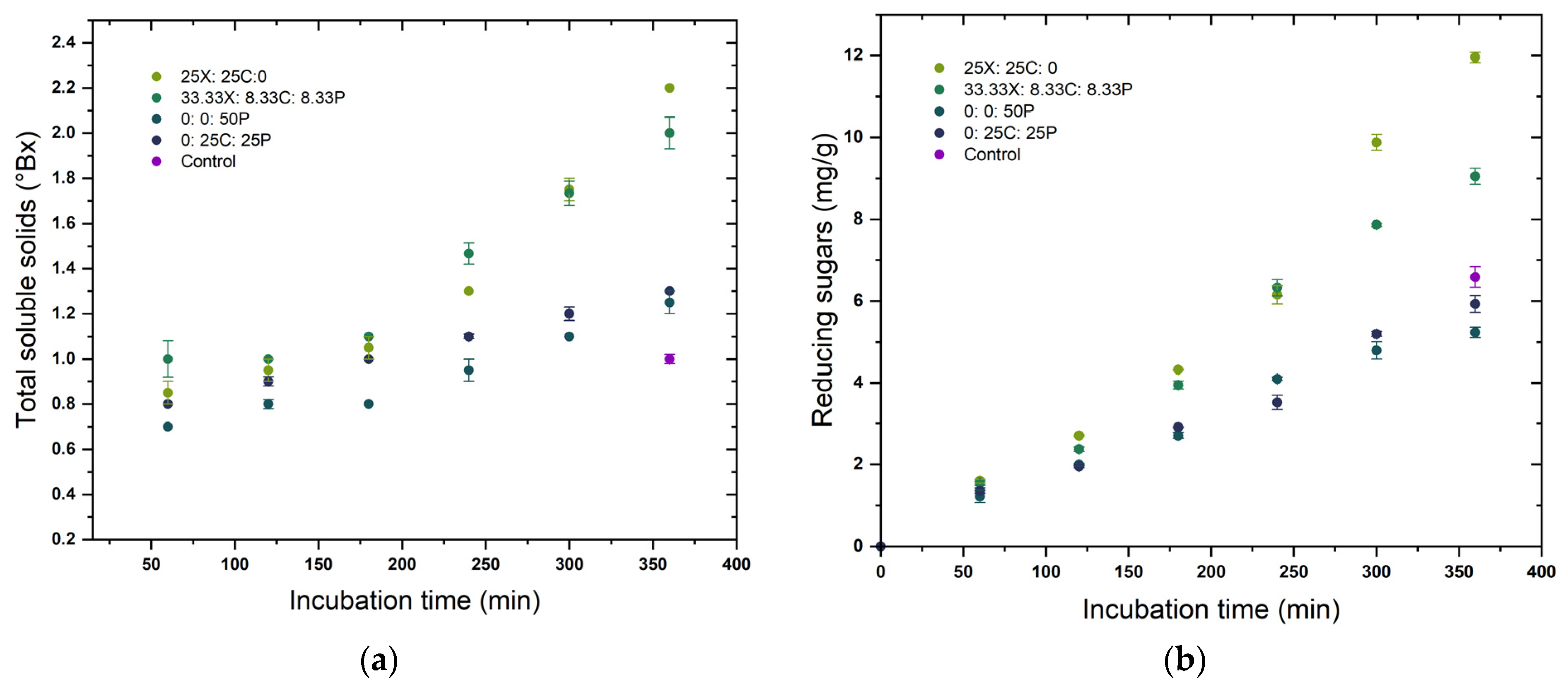
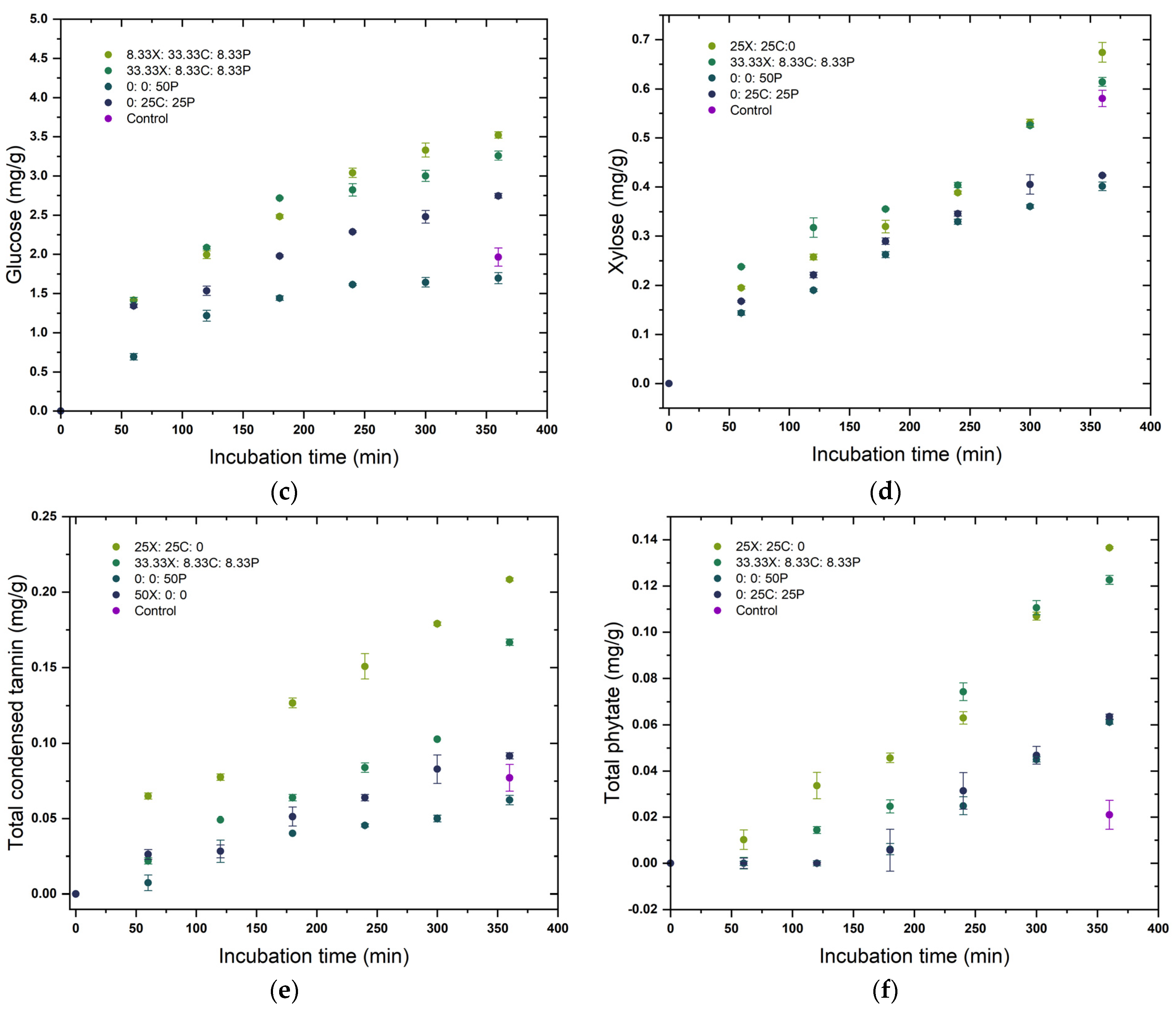
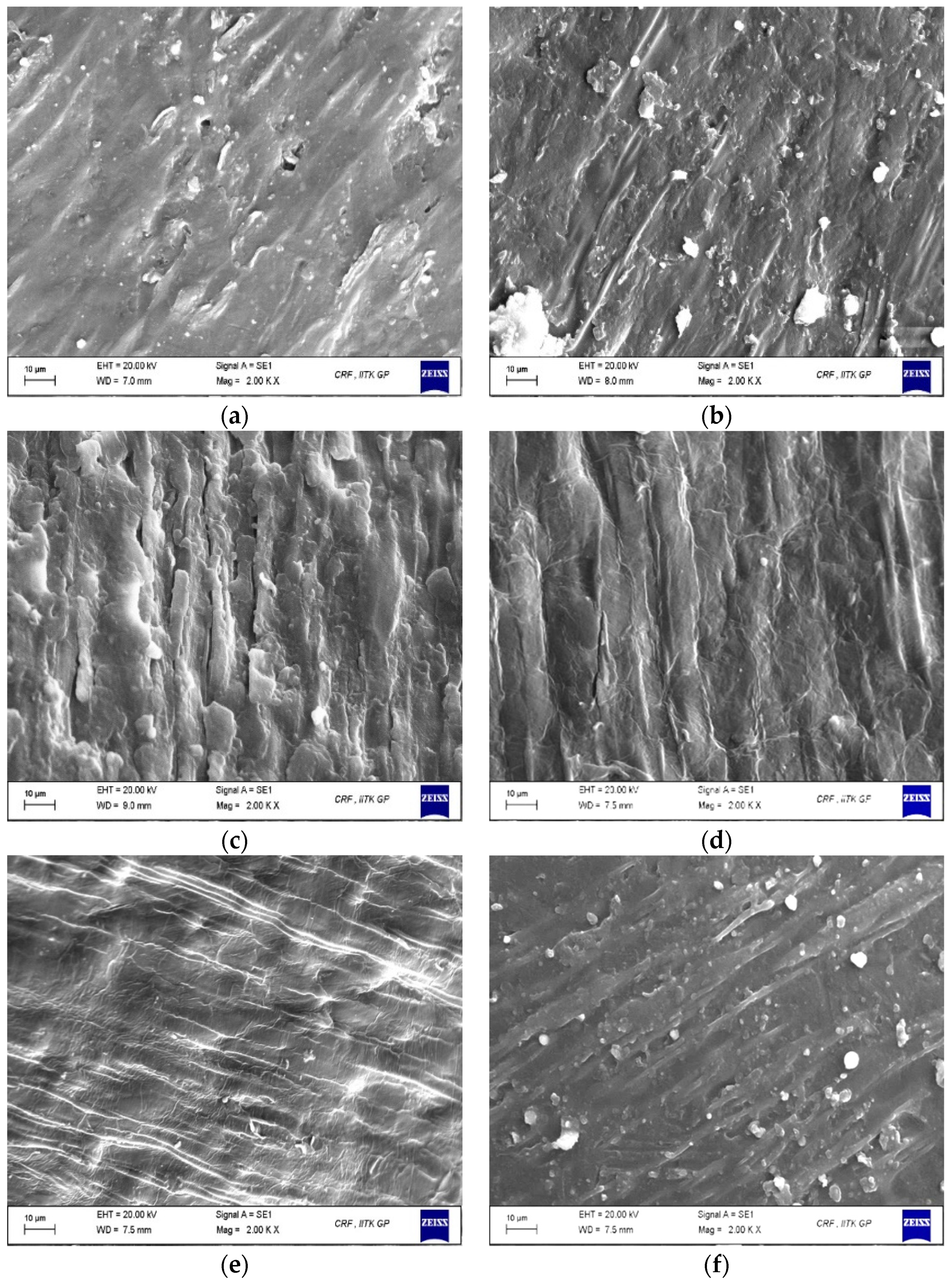
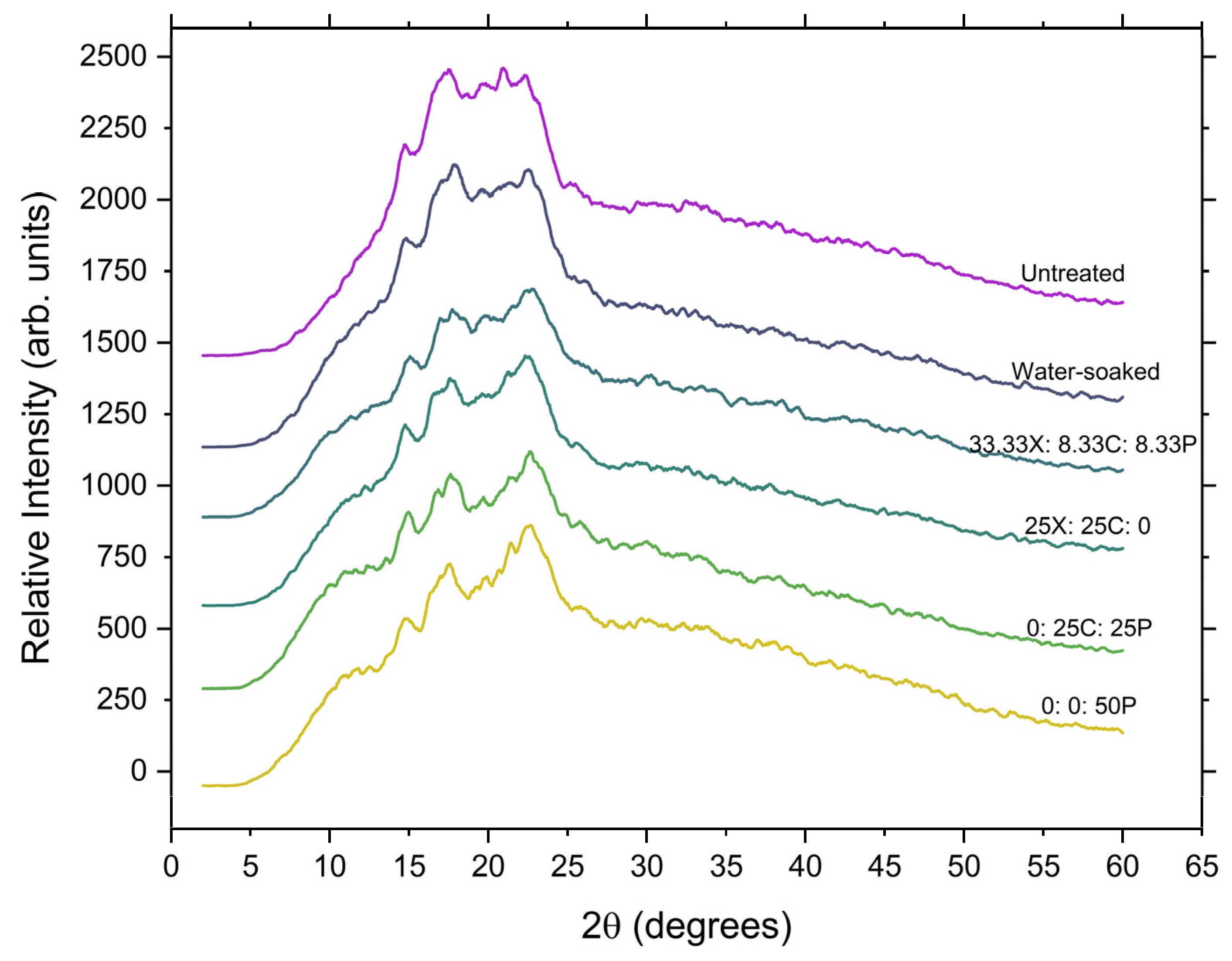
| Runs | Enzyme Cocktail Proportions (mg/100 g dm) | TSS (°Bx) | RS (mg/g) | Glucose (mg/g) | Xylose (mg/g) | GalA (mg/g) | TCT (mg/g) | Phytate (mg/g) | ||
|---|---|---|---|---|---|---|---|---|---|---|
| X | C | P | ||||||||
| 1 | 0 | 0 | 50 | 1.25 ± 0.05 a | 5.23 ± 0.12 a | 1.70 ± 0.03 a | 0.40 ± 0.001 a | 0.21 ± 0.006 | 0.06 ± 0.003 a | 0.06 ± 0.001 a |
| 2 | 0 | 25 | 25 | 1.30 ± 0.00 a,b | 5.92 ± 0.01 b | 2.75 ± 0.02 b | 0.42 ± 0.001 b | 0.25 ± 0.002 | 0.10 ± 0.003 c,d | 0.06 ± 0.001 a |
| 3 | 0 | 50 | 0 | 1.35 ± 0.05 a,b,c | 6.24 ± 0.12 c | 2.97 ± 0.03 c | 0.46 ± 0.006 c | 0.18 ± 0.001 | 0.11 ± 0.00 d | 0.07 ± 0.007 b |
| 4 | 8.33 | 8.33 | 33.3 | 1.45 ± 0.05 c,d | 7.52 ± 0.04 e | 2.92 ± 0.02 c | 0.46 ± 0.005 c,d | 0.22 ± 0.008 | 0.11 ± 0.003 d | 0.08 ± 0.001 c,d |
| 5 | 8.33 | 33.3 | 8.33 | 1.50 ± 0.04 d,e | 7.72 ± 0.05 e,f | 3.52 ± 0.04 f | 0.48 ± 0.007 d | 0.17 ± 0.004 | 0.17 ± 0.005 g | 0.09 ± 0.002 d |
| 6 | 16.67 | 16.67 | 16.67 | 1.60 ± 0.02 e,f | 8.83 ± 0.10 g | 3.24 ± 0.03 d,e | 0.53 ± 0.002 e | 0.22 ± 0.002 | 0.15 ± 0.01 f | 0.12 ± 0.001 e |
| 7 | 25 | 0 | 25 | 1.70 ± 0.00 f | 7.89 ± 0.17 f | 2.83 ± 0.01 b | 0.52 ± 0.01 e | 0.19 ± 0.001 | 0.08 ± 0.002 b | 0.08 ± 0.002 c,d |
| 8 | 25 | 25 | 0 | 2.20 ± 0.01 h | 11.96 ± 0.01 h | 3.16 ± 0.05 d | 0.67 ± 0.01 g | 0.15 ± 0.002 | 0.21 ± 0.001 h | 0.14 ± 0.004 f |
| 9 | 33.3 | 8.33 | 8.33 | 2.00 ± 0.09 g | 9.05 ± 0.05 g | 3.26 ± 0.02 e | 0.61 ± 0.002 f | 0.20 ± 0.006 | 0.13 ± 0.002 e | 0.12 ± 0.001 e |
| 10 | 50 | 0 | 0 | 1.40 ± 0.03 b,c,d | 7.01 ± 0.10 d | 2.93 ± 0.01 c | 0.51 ± 0.003 e | 0.16 ± 0.005 | 0.09 ± 0.007 b,c | 0.08 ± 0.002 b,c |
| Parameter | Whole Grain Flour | Decorticated Grain Flour |
|---|---|---|
| Moisture content (%) | 10.10 ± 0.07 | 8.59 ± 0.06 |
| Protein (g/100 g) | 11.59 ± 0.30 | 5.50 ± 0.01 |
| Fat (g/100 g) | 3.09 ± 0.21 | 2.46 ± 0.07 |
| Ash (g/100 g) | 2.39 ± 0.18 | 1.56 ± 0.14 |
| Crude fibre (g/100 g) | 7.17 ± 0.45 | 5.45 ± 0.24 |
| Carbohydrates (g/100 g) | 65.65 ± 0.31 | 76.44 ± 0.48 |
| Dietary fibre (g/100 g) | 35.20 ± 0.03 | 25.44 ± 0.08 |
| Iron (mg/100 g) | 5.65 ± 0.42 | 3.33 ± 0.23 |
| Zinc (mg/100 g) | 4.02 ± 0.14 | 1.93 ± 0.06 |
| Total phenols (mg GAE/100 g) | 39.32 ± 0.03 | 34.29 ± 0.01 |
| Total condensed tannin (mg CE/g) | 5.43 ± 0.13 | 1.44 ± 0.03 |
| Total phytates (mg/g) | 17.93 ± 0.02 | 15.79 ± 0.03 |
| Model Terms | TSS (°Bx) | RS (mg/g) | Glucose (mg/g) | Xylose (mg/g) | GalA (mg/g) | TCT (mg/g) | Phytate (mg/g) |
|---|---|---|---|---|---|---|---|
| Model | 6.59 | 15.48 | 9.44 | 9.35 | 3.15 | 16.95 | 11.76 |
| Linear mixture | 5.45 | 14.98 * | 17.22 * | 14.96 * | 5.11 | 21.58 * | 11.44 * |
| XC | 18.45 * | 52.79 ** | 5.00 | 22.69 * | 0.358 | 46.23 ** | 30.23 * |
| XP | 3.16 | 6.63 | 0.868 | 2.81 | 0.66 | 0.077 | 1.33 |
| CP | 0.490 | 0.076 | 3.80 | 0.072 | 6.33 | 1.06 | 0.157 |
| XCP | - | 0.979 | 2.17 | 0.998 | - | 0.056 | 1.49 |
| pmodel | 0.0458 * | 0.0233 * | 0.0465 * | 0.0470 * | 0.124 ns | 0.0205 * | 0.0343 * |
| R2 | 0.892 | 0.969 | 0.949 | 0.949 | 0.474 | 0.971 | 0.959 |
| Adj R2 | 0.756 | 0.906 | 0.849 | 0.84 | 0.324 | 0.914 | 0.878 |
| Parameter | Goal | Importance | Predicted Value (D = 0.78) | Experimental Value | Relative Error (%) |
|---|---|---|---|---|---|
| Xylanase (mg/100 g dm) | In range | - | 33.3 | 33.3 | - |
| Cellulase (mg/100 g dm) | In range | - | 8.3 | 8.3 | - |
| Pectinase (mg/100 g dm) | In range | - | 8.3 | 8.3 | - |
| TSS (°Bx) | Max | 3 | 1.86 | 1.96 ± 0.04 | 5.10 |
| Reducing sugars (mg/g) | Max | 3 | 9.34 | 9.19 ± 0.11 | 1.63 |
| Glucose (mg/g) | Max | 3 | 3.27 | 3.22 ± 0.03 | 1.55 |
| Xylose (mg/g) | Max | 3 | 0.58 | 0.60 ± 0.03 | 3.33 |
| Galacturonic acid (mg/g) | - | - | 0.18 | 0.19 ± 0.01 | 5.26 |
| Total condensed tannins (mg/g) | Max | 3 | 0.14 | 0.14 ± 0.01 | 0.71 |
| Total phytate (mg/g) | Max | 3 | 0.12 | 0.11 ± 0.01 | 6.20 |
Disclaimer/Publisher’s Note: The statements, opinions and data contained in all publications are solely those of the individual author(s) and contributor(s) and not of MDPI and/or the editor(s). MDPI and/or the editor(s) disclaim responsibility for any injury to people or property resulting from any ideas, methods, instructions or products referred to in the content. |
© 2023 by the authors. Licensee MDPI, Basel, Switzerland. This article is an open access article distributed under the terms and conditions of the Creative Commons Attribution (CC BY) license (https://creativecommons.org/licenses/by/4.0/).
Share and Cite
Sruthi, N.U.; Rao, P.S.; Bennett, S.J.; Bhattarai, R.R. Formulation of a Synergistic Enzyme Cocktail for Controlled Degradation of Sorghum Grain Pericarp. Foods 2023, 12, 306. https://doi.org/10.3390/foods12020306
Sruthi NU, Rao PS, Bennett SJ, Bhattarai RR. Formulation of a Synergistic Enzyme Cocktail for Controlled Degradation of Sorghum Grain Pericarp. Foods. 2023; 12(2):306. https://doi.org/10.3390/foods12020306
Chicago/Turabian StyleSruthi, N. U., Pavuluri Srinivasa Rao, Sarita Jane Bennett, and Rewati Raman Bhattarai. 2023. "Formulation of a Synergistic Enzyme Cocktail for Controlled Degradation of Sorghum Grain Pericarp" Foods 12, no. 2: 306. https://doi.org/10.3390/foods12020306
APA StyleSruthi, N. U., Rao, P. S., Bennett, S. J., & Bhattarai, R. R. (2023). Formulation of a Synergistic Enzyme Cocktail for Controlled Degradation of Sorghum Grain Pericarp. Foods, 12(2), 306. https://doi.org/10.3390/foods12020306





